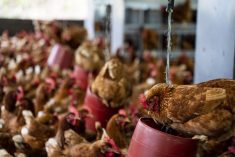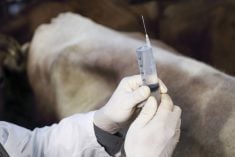There has been volumes written on antibiotic/antimicrobial resistance in the last several years.
This article will highlight some of the key points on how well the cattle industry is doing so far and predict what changes veterinarians may make in their recommendations going forward. For those of you who crave more detailed information, there are several very good brochures and websites that give very factual and current information on the subject.
This is important when we are trying to explain to the average urbanite how the entire industry is really following the guidelines about prudent usage of antimicrobials.
Read Also

Horns aren’t unlocking anytime soon on livestock transport standards
Standards good enough meet the definition of “humane” animal transportation still vary widely between what what industry wants, what animal rights advocates want and, between the two, what federal regulators decide is good enough.
We hear the public and industry talking about terms like ‘raised without antibiotics.’ This has severe ramifications from an animal welfare perspective. Simply stated, it is the reason we have established withdrawal periods by law so there are no antibiotic or other drug residues from things such as NSAIDs (non-steroidal anti-inflammatory drugs) or vaccines in our meat or milk.
The best brochure I have seen is Worried about Antibiotic Use and Resistance in Cattle? put out by the Alberta Beef Producers. (It can be downloaded at www.albertabeef.org by searching for ‘worried about antibiotic use.’) It explains the four main categories of antimicrobials. Category 1 is for antibiotics with very high importance in human medicine and the brochure gives examples of ones we use for cattle, such as Excede or Baytril.
The ‘very high’ and ‘high’ importance categories make up less than two per cent of the antimicrobials used in cattle production. There is also a big difference in the classes of antibiotics used for humans versus those used in cattle. But we must still think twice before we use them and only use Category 1 drugs for treatment of severe medical conditions such as severe pneumonia. Veterinarians continually advise using the least critical category that is still likely to work on the condition at hand.
They are also doing more culture and sensitivity tests during autopsies, especially when in cases where the animal did not respond to drugs that previously worked. This allows a lab to grow the bacteria causing the illness and uses little discs impregnated with antibiotics to actually see which ones work. This is a much better scientific approach to treatment and should provide a higher success rate. (But since these tests take a couple of days, veterinarians have to prescribe treatments based on previous protocols and success rates in the meantime.)
The possibility of resistant bacteria moving from cattle to humans is very remote because of the very few drugs used in Category 1 plus the fact that resistant bacteria would need to get through the packing plant and all the precautions used (such as steam sterilization, UV light and a very clean environment) through the cooking process and into a person. And then the person would have to have that particular antibiotic prescribed by the doctor. This is a very unlikely chain of events.
There is now a research cluster involving head researcher Dr. Tim McCallister and researchers from the cattle industry and veterinary colleges looking at all these potential pathways to make sure all possibilities have been looked at. This alone is very positive evidence the industry is doing its due diligence to protect livestock production and people.
There’s a great quote from veterinarian Dr. Craig Dorin of Airdrie: “It is our privilege and not our right to be able to use antibiotics in the animals we take care of.”
All the surveillance we are doing in the industry has found drug resistance levels to be very low in beef. That doesn’t mean they can’t increase and generally, if resistance is found, the bacteria are resistant to most antibiotics in the same family of drugs. Veterinarians know this and will prescribe a different family of antibiotics if need be.
This year, your veterinarian will be much more involved with antimicrobials used in production animal medicine, especially those that were non-prescription (for the most part) and administered in feed or water. More than 75 per cent of the drugs are used in feed, so enhanced oversight at this level is where you as a producer will see the most changes. These are all steps that will be positive in reducing antibiotic usage where possible and using the most effective ones for the condition at hand.
The first thing removed from antibiotic labelling is the growth promotant indications, which are coming off this year. It is true that reduced disease incidence typically leads to increased growth as a secondary benefit — but now your veterinarian will have to have a medical reason to prescribe.
The Beef Cattle Research Council has another excellent resource at www.beefresearch.ca/amr. This contains clear information as well as a clearly laid-out, seven-minute video that everyone in the cattle industry should watch. We need to get back to management practices that we know will minimize sickness and hence antibiotic usage. This includes calves receiving adequate quality and quantity of colostrum (colostrum is the best ‘drug’ one can use), low-stress weaning, and pre-immunization of calves up to two weeks before weaning. As well, satellite and Internet sales eliminate lots of commingling.
All these practices can definitely reduce the usage of antimicrobials. I know that’s easier said than done, but the potential for reduction in antimicrobial usage is great.
As well, pharmaceutical companies are now focusing more and more on vaccinology so you will see broader-coverage vaccines for viruses and bacteria. Intranasal vaccines can provide quicker coverage, and technology has (and will continue to) improve the degree of immunity and length of coverage over time.
The future will most likely see more vaccines replacing antimicrobials. It is far better to prevent by management and vaccination than treat with antibiotics. To combat resistance, veterinary communities will focus on four things: Prevention, Production, Control, and Therapy.
Also, use parasite treatments as reducing parasites in your herd will also stimulate cattle’s natural immune system. This, along with proper nutrition, minimizes sickness.
Another good resource is the Alberta Veterinary Medical Association website (www.raisedwithcare.ca). It is interactive and there are some quizzes you can take to test your knowledge. The questions you get wrong become an educating experience.
I encourage you all to check out these resources — and tell the public that we in the cattle industry are doing the right thing and helping in the global battle against antimicrobial resistance.
Generally speaking, we are already doing a good job but there is always room for improvement. So question your veterinarian and ask yourself if there is a better way if antimicrobial usage seems too frequent on your operation.
Responsible antibiotic usage is not about residues — we already do a fantastic job at that. It is about using the right drug for the right bug and for the right length of time.
Take pride in the fact the cattle industry is in many ways taking the lead and the medical profession can learn a lot from what you do. Tell your story.
This article was originally published on the Manitoba Co-operator.
















